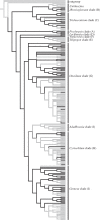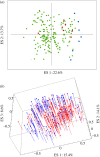Convergent evolution of floral signals underlies the success of Neotropical orchids
- PMID: 23804617
- PMCID: PMC3712443
- DOI: 10.1098/rspb.2013.0960
Convergent evolution of floral signals underlies the success of Neotropical orchids
Abstract
The great majority of plant species in the tropics require animals to achieve pollination, but the exact role of floral signals in attraction of animal pollinators is often debated. Many plants provide a floral reward to attract a guild of pollinators, and it has been proposed that floral signals of non-rewarding species may converge on those of rewarding species to exploit the relationship of the latter with their pollinators. In the orchid family (Orchidaceae), pollination is almost universally animal-mediated, but a third of species provide no floral reward, which suggests that deceptive pollination mechanisms are prevalent. Here, we examine floral colour and shape convergence in Neotropical plant communities, focusing on certain food-deceptive Oncidiinae orchids (e.g. Trichocentrum ascendens and Oncidium nebulosum) and rewarding species of Malpighiaceae. We show that the species from these two distantly related families are often more similar in floral colour and shape than expected by chance and propose that a system of multifarious floral mimicry--a form of Batesian mimicry that involves multiple models and is more complex than a simple one model-one mimic system--operates in these orchids. The same mimetic pollination system has evolved at least 14 times within the species-rich Oncidiinae throughout the Neotropics. These results help explain the extraordinary diversification of Neotropical orchids and highlight the complexity of plant-animal interactions.
Keywords: Neotropical plant communities; Oncidiinae; convergent evolution; deceptive pollination; insect colour vision.
Figures




Similar articles
-
Mechanisms and evolution of deceptive pollination in orchids.Biol Rev Camb Philos Soc. 2006 May;81(2):219-35. doi: 10.1017/S1464793105006986. Biol Rev Camb Philos Soc. 2006. PMID: 16677433 Review.
-
On the success of a swindle: pollination by deception in orchids.Naturwissenschaften. 2005 Jun;92(6):255-64. doi: 10.1007/s00114-005-0636-y. Naturwissenschaften. 2005. PMID: 15931514 Review.
-
Orchid pollination by sexual deception: pollinator perspectives.Biol Rev Camb Philos Soc. 2011 Feb;86(1):33-75. doi: 10.1111/j.1469-185X.2010.00134.x. Biol Rev Camb Philos Soc. 2011. PMID: 20377574 Review.
-
So small and so rich: diversity of floral resources in miniature Oncidiinae (Orchidaceae) and their relation to pollinators.Plant Biol (Stuttg). 2021 Mar;23(2):259-266. doi: 10.1111/plb.13221. Epub 2020 Dec 31. Plant Biol (Stuttg). 2021. PMID: 33222376
-
Comparative reproductive biology and pollinator specificity among sympatric Gomesa (Orchidaceae: Oncidiinae).Plant Biol (Stuttg). 2017 Mar;19(2):147-155. doi: 10.1111/plb.12525. Epub 2016 Dec 4. Plant Biol (Stuttg). 2017. PMID: 27860055
Cited by
-
Flower colour diversity seen through the eyes of pollinators. A commentary on: 'Floral colour structure in two Australian herbaceous communities: it depends on who is looking'.Ann Bot. 2019 Sep 24;124(2):viii-ix. doi: 10.1093/aob/mcz107. Ann Bot. 2019. PMID: 31214687 Free PMC article.
-
Different pollinator assemblages ensure reproductive success of Cleisostoma linearilobatum (Orchidaceae) in fragmented holy hill forest and traditional tea garden.Sci Rep. 2016 Feb 24;6:21435. doi: 10.1038/srep21435. Sci Rep. 2016. PMID: 26907369 Free PMC article.
-
Exploring the evolutionary origin of floral organs of Erycina pusilla, an emerging orchid model system.BMC Evol Biol. 2017 Mar 23;17(1):89. doi: 10.1186/s12862-017-0938-7. BMC Evol Biol. 2017. PMID: 28335712 Free PMC article.
-
Nonrandom Composition of Flower Colors in a Plant Community: Mutually Different Co-Flowering Natives and Disturbance by Aliens.PLoS One. 2015 Dec 9;10(12):e0143443. doi: 10.1371/journal.pone.0143443. eCollection 2015. PLoS One. 2015. PMID: 26650121 Free PMC article.
-
Visual and Olfactory Floral Cues of Campanula (Campanulaceae) and Their Significance for Host Recognition by an Oligolectic Bee Pollinator.PLoS One. 2015 Jun 10;10(6):e0128577. doi: 10.1371/journal.pone.0128577. eCollection 2015. PLoS One. 2015. PMID: 26060994 Free PMC article.
References
-
- Levin DA, Anderson WW. 1970. Competition for pollinators between simultaneously flowering species. Am. Nat. 104, 455–46710.2307/2459314 (doi:10.2307/2459314) - DOI - DOI
-
- Vamosi JC, Knight TM, Steets JA, Mazer SJ, Burd M, Ashman T-L. 2006. Pollination decays in biodiversity hotspots. Proc. Natl Acad. Sci. USA 103, 956–96110.1073/pnas.0507165103 (doi:10.1073/pnas.0507165103) - DOI - DOI - PMC - PubMed
-
- Herrera CM. 1993. Selection on complexity of corolla outline in a hawkmoth-pollinated violet. Evol. Trends Plants 7, 9–13
-
- McEwen JR, Vamosi JC. 2010. Floral colour versus phylogeny in structuring subalpine flowering communities. Proc. R. Soc. B 277, 2957–296510.1098/rspb.2010.0501 (doi:10.1098/rspb.2010.0501) - DOI - DOI - PMC - PubMed
-
- Dyer AG, Boyd-Gerny S, McLoughlin S, Rosa MGP, Simonov V, Wong BBM. 2012. Parallel evolution of angiosperm colour signals: common evolutionary pressures linked to hymenopteran vision. Proc. R. Soc. B 279, 3606–361510.1098/rspb.2012.0827 (doi:10.1098/rspb.2012.0827) - DOI - DOI - PMC - PubMed
Publication types
MeSH terms
LinkOut - more resources
Full Text Sources
Other Literature Sources

